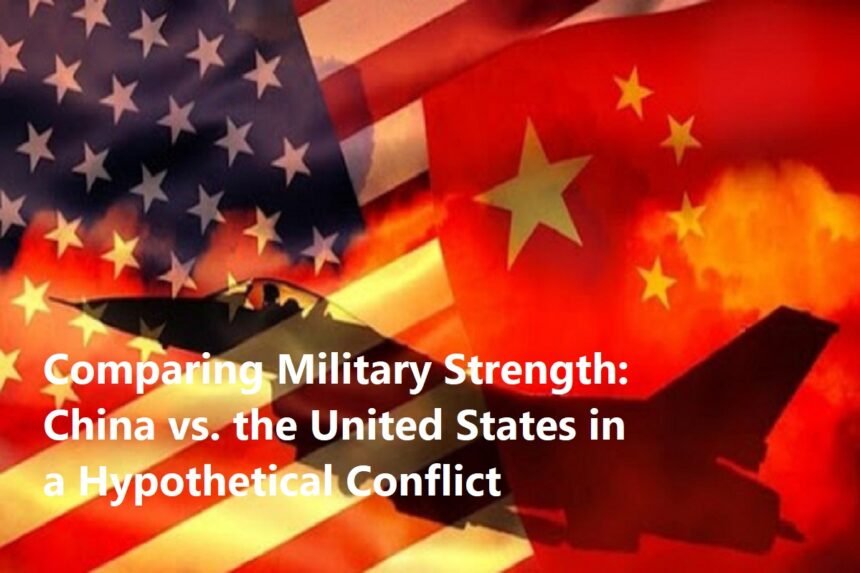The prospect of a direct military confrontation between China and the United States—the world’s two largest economies and nuclear-armed superpowers—has become a focal point of global security debates. While such a conflict remains unlikely due to its catastrophic risks, comparing their military capabilities reveals critical asymmetries in technology, geography, and strategic doctrine.
Military Budgets and Resources
The U.S. maintains the world’s largest defense budget, spending 886 billion in 2023, China’s officially reported 886 billion in 2023, China’s officially reported 230 billion. However, China’s actual military expenditure is estimated to be significantly higher when accounting for opaque funding channels and dual-use technologies. The U.S. leverages its financial might to sustain a global network of 750 overseas military bases and cutting-edge R&D programs. China, meanwhile, prioritizes modernization, focusing on anti-access/area denial (A2/AD) systems, hypersonic missiles, and artificial intelligence (AI) to counter U.S. advantages.
Technological Edge
The U.S. retains superiority in advanced weaponry, including stealth aircraft (F-35, B-21 Raider), nuclear-powered submarines, and carrier strike groups (11 active aircraft carriers vs. China’s 3). Its combat experience and integration of NATO-standard systems provide a tactical edge. Conversely, China has rapidly closed gaps in key areas:
- Hypersonic Missiles: China’s DF-17 hypersonic glide vehicle, capable of evading U.S. missile defenses, poses a strategic threat to Pacific bases and carriers.
- Cyber and Space Warfare: Both nations invest heavily in cyber capabilities, but China’s state-linked hacking groups reportedly target U.S. infrastructure and defense networks.
- AI and Drone Swarms: China leads in AI-driven drone swarms, which could overwhelm traditional defenses.
Naval and Air Power
The U.S. Navy dominates blue-water operations, with superior carrier groups and submarine fleets. However, China’s People’s Liberation Army Navy (PLAN) has become the largest numerically, with over 355 ships, including advanced Type 055 destroyers and nuclear submarines. In a regional conflict near China’s coast (e.g., Taiwan or the South China Sea), China’s land-based missiles (DF-21D “carrier killers”) and dense sensor networks could challenge U.S. naval mobility.
In airpower, the U.S. boasts more fifth-generation fighters (over 450 F-35s), while China’s J-20 stealth jets (200+) lack the same engine sophistication. However, China’s vast arsenal of ballistic and cruise missiles (1,500+ aimed at Taiwan) could cripple regional U.S. airfields early in a conflict.
Nuclear Arsenals
The U.S. nuclear arsenal (5,044 warheads) far exceeds China’s estimated 500. Yet China is expanding its capabilities, developing hypersonic nuclear delivery systems (DF-ZF) and silo fields in Xinjiang. U.S. superiority lies in its triad (air, sea, land), while China adheres to a “minimum deterrence” doctrine, focusing on survivability rather than parity.
Geography and Logistics
China’s proximity to potential flashpoints like Taiwan or the South China Sea grants logistical advantages, enabling rapid mobilization of forces and missile strikes. The U.S., reliant on distant bases in Japan, Guam, and South Korea, faces vulnerabilities in sustaining supply chains under Chinese A2/AD systems. Conversely, the U.S. could leverage alliances (Japan, Australia, NATO) to impose a blockade on China’s energy imports via the Malacca Strait, crippling its economy.
Economic and Industrial Capacity
China’s manufacturing base—the world’s largest—could theoretically outproduce the U.S. in wartime. However, reliance on imported oil and semiconductors exposes critical weaknesses. The U.S., with robust domestic energy production and tech innovation, has greater resilience but less centralized control over defense industries.
Cyber and Asymmetric Warfare
Cyberattacks would likely precede kinetic strikes, targeting power grids, communications, and financial systems. China’s “Great Firewall” and centralized control may offer defensive advantages, while the U.S. excels in offensive cyber operations. Both nations could deploy AI for disinformation campaigns, drone warfare, and electronic jamming.
Strategic Vulnerabilities
- U.S. Challenges: Overextension across global commitments, political polarization, and high casualty sensitivity.
- China’s Weaknesses: Lack of combat experience, potential internal instability, and dependence on global trade routes.
Conclusion: A War of Attrition or Mutual Assured Disruption?
A full-scale Sino-American war would devastate the global economy and risk nuclear escalation. In conventional terms, the U.S. holds qualitative advantages, but China’s regional dominance and asymmetric tactics could neutralize them in the Indo-Pacific. Ultimately, victory would hinge on objectives: China might prevail in a short-range conflict over Taiwan, while the U.S. could leverage alliances for prolonged warfare. However, the interdependence of their economies and the existential threat of nuclear weapons make such a scenario a grim last resort for both nations.












